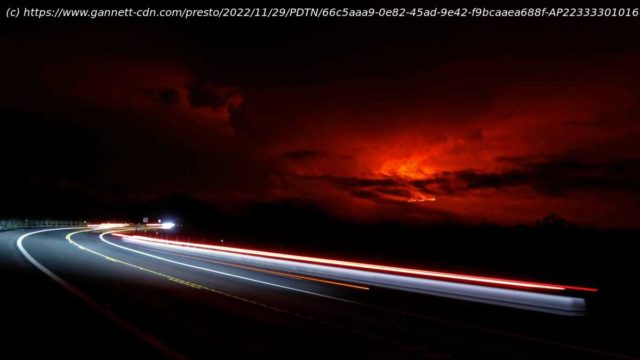A breakdown of where Mauna Loa is located and the possible threats it poses.
Honolulu — Lava is shooting 100 feet to 200 feet (30 to 60 meters) into the air as Hawaii’s Mauna Loa, the world’s largest active volcano, erupts for the first time in nearly 40 years.
For now, lava is not threatening any homes or communities and no evacuation orders have been issued. Lava could eventually reach neighborhoods as it flows downhill though it could take a week or more for molten rock to reach populated areas.
Mauna Loa is spewing sulfur dioxide and other volcanic gases. They form volcanic smog, or vog, when they mix with vapor, oxygen and dust in sunlight. As a result, state health officials are urging people to cut back on outdoor exercise and other activities that cause heavy breathing.
Mauna Loa last erupted in 1984. Its smaller, more active neighbor, Kilauea volcano, has been erupting continuously for more than a year since September 2021.
Mauna Loa is one of five volcanoes that together make up the Big Island of Hawaii, which is the southernmost island in the Hawaiian archipelago. It’s not the tallest (that title goes to Mauna Kea) but it’s the largest and makes up about half of the island’s land mass.
It sits immediately north of Kilauea volcano, which is well-known for a 2018 eruption that destroyed 700 homes and sent rivers of lava spreading across farms and into the ocean.
Mauna Loa last erupted 38 years ago. The current eruption is its 34th since written history began in 1843.
The Big Island is mostly rural and hosts cattle ranches and coffee farms but it is also home to a few small cities, including the county seat of Hilo, which has a population of 45,000.
It’s about 200 miles (320 kilometers) south of Hawaii’s most populous island, Oahu, where the state capital, Honolulu, and beach resort Waikiki are both located.
Mauna Loa’s volume is estimated to be at least 18,000 square miles (75,000 square kilometers), making it the world’s largest volcano when measured from the ocean floor to its summit.






